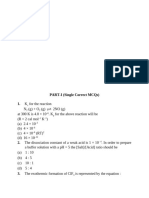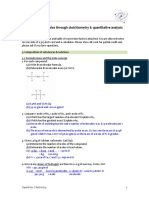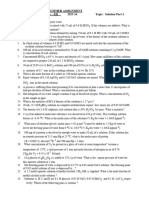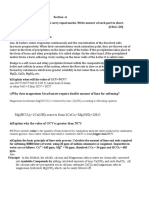Exercises 4
Exercises 4
Uploaded by
Maulida FajriyahCopyright:
Available Formats
Exercises 4
Exercises 4
Uploaded by
Maulida FajriyahCopyright
Available Formats
Share this document
Did you find this document useful?
Is this content inappropriate?
Copyright:
Available Formats
Exercises 4
Exercises 4
Uploaded by
Maulida FajriyahCopyright:
Available Formats
Exercises for Gravimetric Analysis
1. When making equilibrium calculations in which the reaction quotient is set equal
to the equilibrium constant, why must we express solute concentrations in mol/L,
gas pressures in atmospheres (actually in bars), and omit solids, liquids and
solvents?
2. Why is the equilibrium constant for a reaction a dimensionless quantity?
3. Consider the following equilibria.
(1) AgCl(s) º Ag+(aq) + Cl-(aq) K = 1.8 x 10-10
(2) Ag+(aq) + Cl-(aq) º AgCl(aq) K = 2.0 x 103
a) Calculate the equilibrium constant for the reaction AgCl(s) º AgCl(aq).
b) Calculate the concentration of AgCl(aq) in equilibrium with excess
undissolved solid AgCl.
4. Find the equilibrium concentration of La3+(aq) when excess solid La(IO3)3 is
stirred with a solution of 0.050 M LiIO3. Ksp = 1.0 x 10-11 for La(IO3)3.
5. Which salt, MgCO3 (Ksp = 3.5 x 10-8) or CaCO3 (Ksp = 4.5 x 10-9), will be more
soluble in water? Explain.
6. Is it possible to precipitate 99.0% of 0.010 M Ce3+ by adding oxalate (C2O42-)
without precipitating 0.010 M Ca2+?
CaC2O4 Ksp = 1.3 x 10-8
Ce2(C2O4)3 Ksp = 3 x 10-29
7. Why is a high relative supersaturation undesirable in a gravimetric precipitation?
8. What measures can be taken to decrease the relative supersaturation?
Exercises for Gravimetric Analysis
9. Why are ionic precipitates usually washed with an electrolyte solution instead of
pure water?
10. Why is it less desirable to wash a AgCl precipitate with NaNO3(aq) than with
HNO3(aq)?
11. If Ag+ is added to a solution containing 0.10 M Cl-, Br-, I- and CrO32-, in what order
will the anions precipitate? Explain.
AgCl Ksp = 1.8 x 10-10
AgBr Ksp = 5.0 x 10-13
AgI Ksp = 8.3 x 10-17
Ag2CrO4 Ksp = 1.2 x 10-12
12. Twenty dietary iron tablets with a total mass of 22.131 g were ground and mixed
thoroughly. Then 2.998 g of the powder were dissolved in HNO3 and heated to
convert all iron into Fe3+. Addition of NH3 precipitated Fe2O3 A xH2O, which was
ignited to give 0.264 g Fe2O3 (159.69 g/mol). What is the average mass of
FeSO4 A 7H2O (278.01 g/mol) in each tablet?
13. A 0.649-g sample containing only K2SO4 (174.27 g/mol) and (NH4)2SO4 (132.14
g/mol) was dissolved in water and treated with Ba(NO3)2 to precipitate all sulfate
as BaSO4 (233.39 g/mol). If 0.977 g of precipitate was formed, what is the mass
percent K2SO4 in the sample?
Solutions for Gravimetric Analysis Exercises
You might also like
- Career in CommerceDocument26 pagesCareer in CommerceAshish Puranik100% (3)
- Ans SL MC Test r2 The Amount of Chemical ChangeDocument9 pagesAns SL MC Test r2 The Amount of Chemical ChangeALINo ratings yet
- Stoichiometry 1Document8 pagesStoichiometry 1Raju SinghNo ratings yet
- Tutorial 1 - AnswersDocument8 pagesTutorial 1 - AnswersRaymond Kakala100% (6)
- Theory of Culture Change - Julian StewardDocument14 pagesTheory of Culture Change - Julian Stewardapefreeloader100% (4)
- 1976Document2 pages1976bobothebioguyNo ratings yet
- CHEM1090 Week 12 PASS Worksheet+AnswersDocument10 pagesCHEM1090 Week 12 PASS Worksheet+Answersmlhy2680No ratings yet
- Le Chatelier's - Common Ion EffectDocument13 pagesLe Chatelier's - Common Ion EffectChenoa Sandhi C. SinghNo ratings yet
- Equilibrium Constant AnswersDocument18 pagesEquilibrium Constant Answerselvisfan777No ratings yet
- dpp1 EquilibriumDocument8 pagesdpp1 Equilibriumanuragak2346No ratings yet
- CHE1031 Exam 2: Moles Through Stoichiometry & Quantitative Analysis KEYDocument5 pagesCHE1031 Exam 2: Moles Through Stoichiometry & Quantitative Analysis KEYTG17 NobleNo ratings yet
- Chem 16 3rd Long Exam ReviewerDocument3 pagesChem 16 3rd Long Exam Reviewerggwp21No ratings yet
- CHEM 015 Chemistry For Engineers Worksheet 4 6Document7 pagesCHEM 015 Chemistry For Engineers Worksheet 4 6Ranah Pauolynne LintanNo ratings yet
- CHE1031 Exam 2: Moles Through Stoichiometry & Quantitative Analysis KEYDocument5 pagesCHE1031 Exam 2: Moles Through Stoichiometry & Quantitative Analysis KEYTG17 NobleNo ratings yet
- Solubility Practice 1Document11 pagesSolubility Practice 1docmagnusNo ratings yet
- Part - I: Subjective QuestionsDocument11 pagesPart - I: Subjective Questionspankaj agarwalNo ratings yet
- Assignment 1Document5 pagesAssignment 1Leo PalNo ratings yet
- Solubility Question 2Document14 pagesSolubility Question 2Unidentified Person100% (1)
- Aqueous Equilibria II KSP Solutibilty Homework 2012-03-31Document24 pagesAqueous Equilibria II KSP Solutibilty Homework 2012-03-31alvawa27No ratings yet
- KSP Question A LevelDocument1 pageKSP Question A LevelIlwandy KosasihNo ratings yet
- C15PS3ADocument4 pagesC15PS3ARoxanne de RoxasNo ratings yet
- Moles TestDocument5 pagesMoles TestMahedyNo ratings yet
- 1.3 Formulae, Equations and Amounts of Substance: Relative Mass Relative ChargeDocument19 pages1.3 Formulae, Equations and Amounts of Substance: Relative Mass Relative ChargeRaiyan RahmanNo ratings yet
- กัญกร อโนทิพย์Document14 pagesกัญกร อโนทิพย์Kanyakorn AnothipNo ratings yet
- CHEM 20024 General Chemistry Practice Exam #2Document7 pagesCHEM 20024 General Chemistry Practice Exam #2Yhana Ruth PajitaNo ratings yet
- Solubility Practice 3Document2 pagesSolubility Practice 3docmagnusNo ratings yet
- Tugas Kimter Pak EdwinDocument34 pagesTugas Kimter Pak EdwinaudheaykNo ratings yet
- Homework 2 Che 111Document1 pageHomework 2 Che 111mrpcuNo ratings yet
- Tugas Latihan TitrasiDocument9 pagesTugas Latihan TitrasithomasdarmaNo ratings yet
- Lecture Notes 12. Solubility Product ConstantDocument6 pagesLecture Notes 12. Solubility Product Constantannmarie0% (1)
- Last 5 Years QP-1Document55 pagesLast 5 Years QP-1srinandhuprabhaNo ratings yet
- Third Quarter Assessment Review Sheet AnswersDocument8 pagesThird Quarter Assessment Review Sheet Answersnaseh__nNo ratings yet
- Mole Concept QDocument8 pagesMole Concept Qlumumbaemmanuel72No ratings yet
- BIO1103PE1Document6 pagesBIO1103PE1bambi leeNo ratings yet
- Numericals Work Sheet Xii Chemistry VGDocument6 pagesNumericals Work Sheet Xii Chemistry VGpackiya782No ratings yet
- Ap Equilibrium WorksheetDocument5 pagesAp Equilibrium Worksheetburcak gecNo ratings yet
- IIT JEE 2013-Assignment-Basic Stoichiometry Part - 1Document4 pagesIIT JEE 2013-Assignment-Basic Stoichiometry Part - 1karanmohindroo140% (1)
- SA Solution Worksheet XIIDocument3 pagesSA Solution Worksheet XIIsaudaminipadhan423No ratings yet
- Work Sheet of StoichiometryDocument2 pagesWork Sheet of StoichiometryGamer Scorpio2255No ratings yet
- Mole & Stoichiometry by S.K.sinha See Chemistry Animations atDocument3 pagesMole & Stoichiometry by S.K.sinha See Chemistry Animations atmyiitchemistry50% (2)
- Water Analysis Unit 4Document28 pagesWater Analysis Unit 4simransalujaNo ratings yet
- Solutions QuestionsDocument6 pagesSolutions QuestionsKrishna SenapatiNo ratings yet
- s6 Unit 11. SolubilityDocument44 pagess6 Unit 11. Solubilityyvesmfitumukiza04No ratings yet
- Aams Xi Assgn Cbse EquilibriumDocument2 pagesAams Xi Assgn Cbse EquilibriumNishkarsh kumarNo ratings yet
- Exam 3 2010 SummerDocument10 pagesExam 3 2010 SummernsorsokNo ratings yet
- 11 Chemistry PP Ch1 Some Basic Concepts Chemistry 1Document6 pages11 Chemistry PP Ch1 Some Basic Concepts Chemistry 1Jwalant0% (1)
- Unit 9. Sol Ubility Equilibria Solubility Equil Ibrium: Chem 301 LectureDocument4 pagesUnit 9. Sol Ubility Equilibria Solubility Equil Ibrium: Chem 301 LectureChelsea RubioNo ratings yet
- Stoichiometry ProblemsDocument7 pagesStoichiometry ProblemsFitri AnnisakNo ratings yet
- Chemistry 1A Fall 2010 Exam 2 Key Chapters 4 (Part), 5, 6, and 7 (Part)Document7 pagesChemistry 1A Fall 2010 Exam 2 Key Chapters 4 (Part), 5, 6, and 7 (Part)jasminp8No ratings yet
- Tugas Latihan TitrasiDocument9 pagesTugas Latihan TitrasithomasdarmaNo ratings yet
- How Is Henry's Law Constant K 8. How Is Solubility of A Gas in A Liquid Related To Temperature?Document6 pagesHow Is Henry's Law Constant K 8. How Is Solubility of A Gas in A Liquid Related To Temperature?Snehashis BoseNo ratings yet
- Solution PDF 2Document4 pagesSolution PDF 2piyushdalai2008No ratings yet
- Solids Liquids SolutionsDocument18 pagesSolids Liquids SolutionsZaheer MohiuddinNo ratings yet
- Mole Concept 2021 Sheet-1Document2 pagesMole Concept 2021 Sheet-1AryanNo ratings yet
- Remedial Classes Question For 12Document6 pagesRemedial Classes Question For 12aparajitakalaiNo ratings yet
- Topic92 AnswersDocument10 pagesTopic92 AnswersNguyen Quang KhaiNo ratings yet
- Exam 2 Review PDFDocument8 pagesExam 2 Review PDFkyle javierNo ratings yet
- KSP SolutibiltyDocument21 pagesKSP SolutibiltyBandita DattaNo ratings yet
- Soln Week 1 XiiDocument20 pagesSoln Week 1 XiiAjay MishraNo ratings yet
- Mole Concept SRGPDocument13 pagesMole Concept SRGPAnvesh KhareNo ratings yet
- Practice Makes Perfect in Chemistry: Oxidation-ReductionFrom EverandPractice Makes Perfect in Chemistry: Oxidation-ReductionRating: 5 out of 5 stars5/5 (1)
- Lampiran 1. Uji Normalitas Data Normalitas Daya Larut Minuman Serbuk Daun Katuk Dan Jambu Biji MerahDocument8 pagesLampiran 1. Uji Normalitas Data Normalitas Daya Larut Minuman Serbuk Daun Katuk Dan Jambu Biji MerahMaulida FajriyahNo ratings yet
- Proposal PKM Ecoenzyme in House 2021 Pages 1-38 - Flip PDF Download - FlipHTML5Document38 pagesProposal PKM Ecoenzyme in House 2021 Pages 1-38 - Flip PDF Download - FlipHTML5Maulida FajriyahNo ratings yet
- 704 2568 3 PBDocument10 pages704 2568 3 PBMaulida FajriyahNo ratings yet
- 3004-Document Text-9678-1-10-20220412Document12 pages3004-Document Text-9678-1-10-20220412Maulida FajriyahNo ratings yet
- Sip Snack & Smoke MenuDocument1 pageSip Snack & Smoke MenuNamrata ChauhanNo ratings yet
- Plano Analítico 11 Classe - Inglês 2024Document5 pagesPlano Analítico 11 Classe - Inglês 2024Ambrósio leonardo LeonardoNo ratings yet
- Prabh FinallllDocument75 pagesPrabh Finallllnavdeep2309No ratings yet
- Productivity and Profitability AnalysisDocument17 pagesProductivity and Profitability AnalysisShikuNo ratings yet
- The Upper Triassic of Northern Middle Siberia Stratigraphy and PalynologyDocument22 pagesThe Upper Triassic of Northern Middle Siberia Stratigraphy and PalynologyYuniss JuliaNo ratings yet
- Fermenter and Its Features 1Document14 pagesFermenter and Its Features 1Akhil Suresh (Synthite Biotech)No ratings yet
- A New Technique of Thin Bed Reservoir Evaluation Using Image Log DataDocument9 pagesA New Technique of Thin Bed Reservoir Evaluation Using Image Log DataHumbang PurbaNo ratings yet
- The Entrepreneur and His Legal Environment PresentationDocument16 pagesThe Entrepreneur and His Legal Environment Presentationbubu100% (1)
- Forklift Accessories Explained: F Orklift PartsDocument2 pagesForklift Accessories Explained: F Orklift Partssid_solanki_786No ratings yet
- DHL & Its E-BusinessDocument15 pagesDHL & Its E-BusinessNivedita Sharma100% (1)
- Running Head: NISSAN CASE STUDYDocument7 pagesRunning Head: NISSAN CASE STUDYAliceJohnNo ratings yet
- Statement of Account: Date Narration Chq./Ref - No. Value DT Withdrawal Amt. Deposit Amt. Closing BalanceDocument7 pagesStatement of Account: Date Narration Chq./Ref - No. Value DT Withdrawal Amt. Deposit Amt. Closing BalanceM ADITYA REDDYNo ratings yet
- Prospectus English 2009-10Document152 pagesProspectus English 2009-10Nadeem KhanNo ratings yet
- PDCT - Hydraulic Torque Wrench - Hangzhou Penad Machinery Co.,LtdDocument4 pagesPDCT - Hydraulic Torque Wrench - Hangzhou Penad Machinery Co.,LtdQS BMDSNo ratings yet
- DLL - Mathematics 4 - Q3 - W10Document3 pagesDLL - Mathematics 4 - Q3 - W10Sofia ReyesNo ratings yet
- Electrical Consideration in OPGW Live LINE InstallationDocument5 pagesElectrical Consideration in OPGW Live LINE InstallationNajim Al-Najim0% (1)
- Experiment No.-3 Aim: To Draw A Line, Triangle and Circle Using Functions of Graphics.h Header File. DescriptionDocument51 pagesExperiment No.-3 Aim: To Draw A Line, Triangle and Circle Using Functions of Graphics.h Header File. DescriptionCSENo ratings yet
- DS 2CD2120F I PDFDocument1 pageDS 2CD2120F I PDFSolihin IsmailNo ratings yet
- Bmed 105 Cells and Tissues (Notes)Document14 pagesBmed 105 Cells and Tissues (Notes)Jobelle MalihanNo ratings yet
- Communication AbilityDocument6 pagesCommunication AbilityVEPON KUMARNo ratings yet
- Draft ANO-033-LCXX-1.0 PCAA TECHNICAL EXAMINATIONS (Flight Crew Licences) For Advance PreparationDocument35 pagesDraft ANO-033-LCXX-1.0 PCAA TECHNICAL EXAMINATIONS (Flight Crew Licences) For Advance PreparationatifrjNo ratings yet
- Lesson 6Document18 pagesLesson 6Kenneth DraperNo ratings yet
- Listening To Connected Speech PDFDocument4 pagesListening To Connected Speech PDFDanielle SoaresNo ratings yet
- Unit Vocabulary Grammar Reading Listenin G Speakin G Culture Clil Writin GDocument3 pagesUnit Vocabulary Grammar Reading Listenin G Speakin G Culture Clil Writin GEdu SantosNo ratings yet
- Green Building Regulations and Specifications - Practice Guide - First Edition1 PDFDocument167 pagesGreen Building Regulations and Specifications - Practice Guide - First Edition1 PDFmk100% (2)
- Urban Customer ProfileDocument3 pagesUrban Customer Profileapi-729987785No ratings yet
- Budget Utilization Request and StatusDocument1 pageBudget Utilization Request and StatusGuiller C. MagsumbolNo ratings yet
- CPE Answer 5Document7 pagesCPE Answer 5Carlos GarciaNo ratings yet





























































































